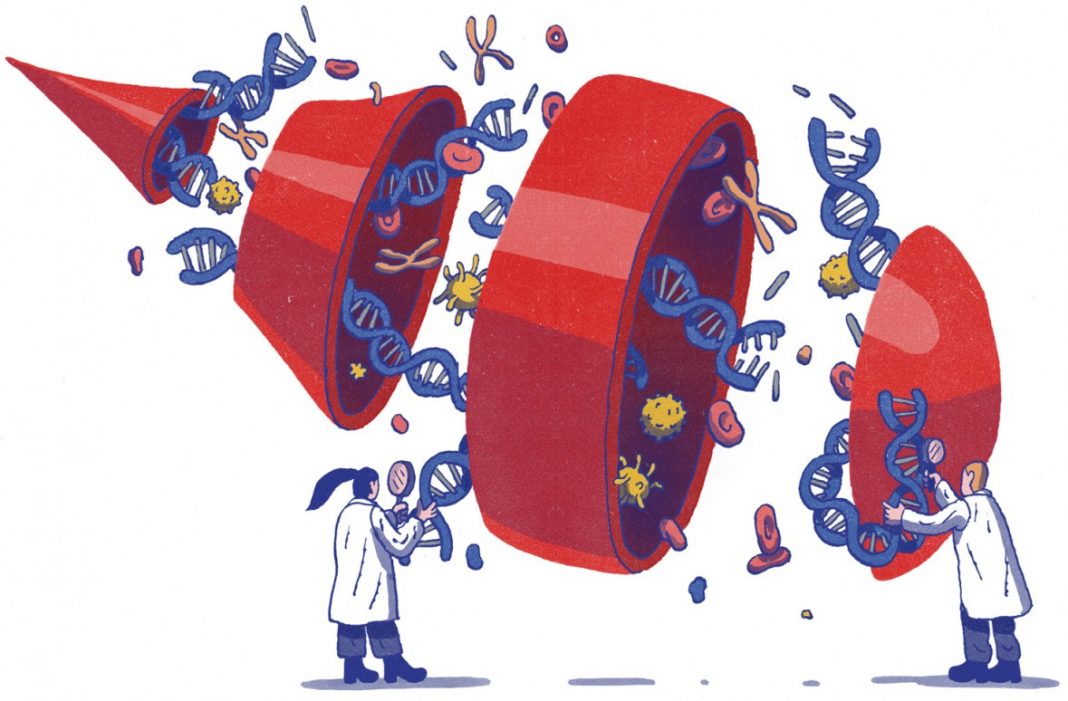Posters are scattered around the clinic at Gibbs Cancer Center in South Carolina, urging volunteers to donate blood in a bid to stop cancer. As a thank you, each person will receive a $25 gift card and the peace of mind that their donation will, in fact, help “determine is a new blood test can be used to detect cancer earlier.”
The company behind the posters is a new startup, Grail Inc. that launched last year. So far the Silicon Valley startup has raised $1.1 billion, placing it among the top three most heavily funded private biotech companies. Investors include Johnson & Johnson, gene-sequencing firm Illumina, and Amazon’s very own Jeff Bezos. The company’s aim is not to find a new wonder drug that will cure cancer, but instead, devise new tests that will enable cancerous tumors to be detected at an early enough stage so that they can be treated successfully.
Although it’s still early days for Grail, a huge effort has already been made in that last year the company began collecting blood from 7,000 cancer patients at Gibbs and other community hospitals. Now, they’re looking to see if it’s possible to create a suitable test with a similar or better accuracy rate than mammograms. But, in order for them to do this, they need blood samples from those who undergo mammograms at centers including the Mayo Clinic. Out of 120,000 women’s blood sample’s it’s been predicted that in around 650 of those, cancer will be detected and breast cancer would begin to develop within a year of the study if no treatment is started. The blood they banked is then analyzed to see if Grail could have accurately predicted cancer from the DNA test on their blood sample.
Because of a large number of people involved in the study, and the fact that they all receive a $25 gift card, the cost of simply paying these volunteers will be $3 million. Grail’s chief business officer, Ken Drazan, says, “The hospitals want to know unequivocally that we are funded. They don’t want to take the risk that we won’t be able to follow through.” Jeff Huber is the head of Grail and he has a personal connection to cancer as sadly lost his wife, Laura, to colorectal cancer shortly before joining the company. He very much believes that his wife’s life could have been saved had the type of test Grail’s developing been available then.
While there are other biotech companies already selling DNA tests for those fighting cancer or are in remission and want to avoid a relapse, Grail’s mission takes a slightly different approach. This is mainly because the company wants screen those that show no symptoms yet, and with that, there is little room for false positives or the wrong results altogether. Competitor Guardant Health has already raised nearly $600 million and head of the company, Helmy Eltoukhy, agrees that screening people at checkup stage is fantastic and they will soon be doing that too.
It’s a no-brainer, really. Two-thirds of all cancers caught early enough are curable. In regards to those that are detected late, almost 80 percent are fatal. But there are issues with screening tests, and it’s not all roses. They have been known to cause false alarms too. “The big problem with this technology is not going to be finding cancer, it will be finding the cancers that should be treated,” says Laura Hercher, a genetic counselor who teaches at Sarah Lawrence College.
Not only will Grail’s tests detect cancer, it will tell the doctor’s where it is, how aggressive it is and the best course of treatment for it. The company is aiming to have its first batch of tests available on the market by 2019. Although this looked a little unrealistic, to begin with, the company has now announced plans to hook up with Cirina, a screening startup founded by Hong Kong molecular anatomist, Dennis Lo, so progress should move much faster now.
Grail’s headquarters are based in a 70,000 square foot premises in Menlo Park, California. Here lies several ultrafast DNA sequencing machines, each one worth a cool million. It’s these machines that allow Grail to analyze blood samples so intensely as to detect cancerous cells. The first known case of success with this type of technology came in 2011 when new, noninvasive prenatal tests were introduced that could scan a pregnant woman’s blood for parts of DNA from the fetus. Surprisingly, these tests also detected cancer.
The company now collects 1,000 gigabytes of raw data from each volunteer’s blood, making it as much as a software company as it is a biotech. The information then gets fed into software that searches for patterns. But the problem lies in knowing what patterns indicate cancer. As of yet, they can’t be certain which features matter most. Is it the size of the fragments? The mutations in the DNA? The chemical modifications found on genetic strands? Or is it a combination of these? “We have not landed on a single strategy that we are taking forward,” says Anne-Renee Hartman, head of clinical development at Grail. “The work that’s been done and published is on people that have cancer. We have to employ every strategy.”
There are hurdles to overcome still when it comes to early detection testing, one of which is that cancer signals may not always show up. According to Luis Diaz, a cancer scientist at Memorial Sloan-Kettering in New York, around 35 to 40 percent of cancer types show no signs at all. “It’s the weak-signal problem,” says Eltoukhy. “That’s why the studies are so big.” The cost of the tests also needs to come down as are not yet cheap enough to use as an everyday doctor’s office test. Accuracy is also key to this being a success a seven a low rate of false positives could cause mass panic and social upset. In order to be the most effective, the tests also need to become more affordable on a whole, but there may be a wait. Huber says “We are not going to offer a $169 test on day one.” For the moment, it’s likely these tests will cost around $1,000 a time. But at the end of the day, who can put a price on someone’s life, really?
More News to Read











